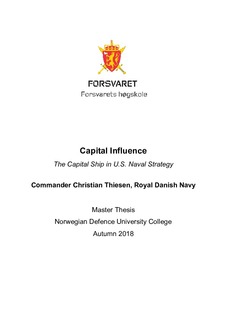| dc.contributor.author | Thiesen, Christian | |
| dc.date.accessioned | 2019-02-05T12:34:18Z | |
| dc.date.available | 2019-02-05T12:34:18Z | |
| dc.date.issued | 2018 | |
| dc.identifier.uri | http://hdl.handle.net/11250/2583956 | |
| dc.description.abstract | The purpose of this study is to explore the role of capital ships in U.S. naval strategy from the end of the Cold War until this day. The study analyses the capital ships’ role within U.S. naval strategy and how this has developed over time. Furthermore the study discusses the future of the supercarrier as the U.S. capital ship. An unambiguous definition of what a capital ship actually is does not exist. The study has therefore used a comparative historic approach in order to define the capital ship.
The definition is: They are the most important ships of their time, they ensure conditions that permit other forces or functions to perform their respective role. In wartime, capital ships secure the use of the sea.
The study is explorative and answers the research question through a qualitative approach and uses theory of naval strategy and Ken Booth’s Naval Trinity as the analytical framework.
The results show, that the supercarrier has been elevated to almost mythological status in the U.S. Navy and institutions, and it will probably take a major war to challenge this status. The supercarrier has become a symbol of U.S. supremacy, and the pillar on which all U.S. naval strategic thinking is done.
However, with the advent of near peer completion on the world’s oceans the Navy is now struggling to define its military role. Its role as a tool of diplomacy on the other hand is very well defined and value-laden.
It was once stated, “capital ships are built to prevent war”, and the U.S. is certainly placing a lot of faith on this approach. | nb_NO |
| dc.description.abstract | Formålet med denne masteropgave er at studere the capital ships rolle i amerikansk flådestrategi siden den Kolde Krig. Opgaven analyserer the capital ships rolle i indenfor amerikansk flådestrategi samt, hvordan denne har udviklet sig over tid. Derudover, diskuteres supercarrier’ens fremtid som amerikansk capital ship. Der findes ikke en entydig definition på hvad et capital ship egentlig er. Opgaven har derfor gennem en historisk komparativ tilgang udarbejdet en definition.
Definitionen lyder: De er deres samtids vigtigste skibe, de sikrer tilstande, som tillader andre styrker at gennemføre deres roller. I krigstid, er det capital ships der sikrer evnen til at benytte havet.
Studien undersøger problemformuleringen gennem en kvalitativ tilgang og benytter maritim teori og Ken Booths maritime treenighed som analytisk rammeværk.
Resultaterne viser, at supercarrier’en er blevet ophøjet til nærmest mytologisk status i den amerikanske flåde og i amerikanske institutioner. Det vil givetvis kræve en større krig hvis dette paradigme skal udfordres for alvor. Supercarrier’en er blevet symbolet på amerikansk overlegenhed og grundlaget for al amerikansk maritim strategisk tænkning.
Det faktum at andre magter nu er trådt ind på den globale scene har medført, at den amerikanske flåde nu har vanskeligt ved at beskrive dette skibs militære rolle. Som et diplomatisk redskab er skibets rolle med veldefineret og værdiladet. Dr. Tim Benbow har en gang udtrykt, at ”capital ships bliver bygget med det formål at undgå krig”. Denne tilgang tillægger USA utvivlsomt stor betydning. | nb_NO |
| dc.language.iso | eng | nb_NO |
| dc.publisher | Forsvarets høgskole | nb_NO |
| dc.subject | Capital ships | nb_NO |
| dc.subject | Flåtestrategi | nb_NO |
| dc.subject | USA | nb_NO |
| dc.title | Capital Influence. The Capital Ship in U.S. Naval Strategy | nb_NO |
| dc.type | Master thesis | nb_NO |
| dc.source.pagenumber | 88 s. | nb_NO |
